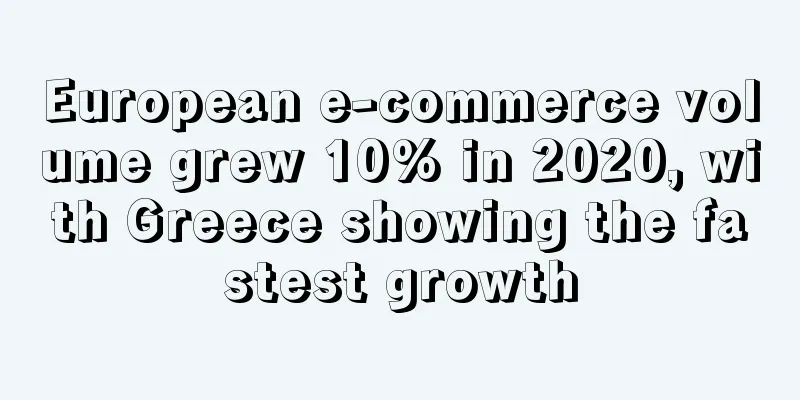European e-commerce volume grew 10% in 2020, with Greece showing the fastest growth

|
Last year, the highest growth rate in European e-commerce turnover was recorded in Greece ( 77% ), as reflected in the 2021 European E-commerce Report jointly released by the Hellenic E-commerce Association, the European E-commerce Association and the European Business Association .
According to the report , the total value of European e-commerce in 2020 increased from 690 billion euros in 2019 to 757 billion euros, an increase of 10% , but a slight decrease compared with 2019 (14%). The epidemic has greatly promoted the development of e-commerce , but the sharp decline in online sales in industries such as tourism and services has made the growth rate relatively stable.
According to research, the epidemic has had a huge impact on the development of the retail industry , and the lockdown has accelerated the current transformation of stores to digitalization and greening . E-commerce is the lifeline of consumers who are unable to buy what they need in stores due to policy restrictions such as government lockdowns .
While e-commerce has not completely offset the losses suffered by SMEs’ physical stores , it has absorbed much of the financial shock. However, further work is needed to ensure that the retail industry can fully leverage digital transformation to move into new markets.
The report shows that Western Europe is the strongest region in terms of B2C e-commerce turnover, accounting for 64% of total turnover in 2020. Southern Europe comes in second with just 16% of total turnover, while Central Europe (8%) and Northern and Eastern Europe (both 6%) come in third.
The leaders in B2C e-commerce turnover remain the United Kingdom ( 236 billion euros ) , France ( 11.2 billion euros ), Germany ( 93.6 billion euros ) and Spain ( 68.4 billion euros ) . However, the highest growth rates in e-commerce turnover were recorded in Greece ( 77% ) , Moldova ( 49% ) , Russia ( 41% ) , Switzerland , North Macedonia ( 37% ) and Sweden ( 36% ).
In addition , Internet usage in Europe increased from 87% in 2019 and 85% in 2018 to 89% in 2020, including Western Europe (95%). The number of online shoppers grew faster in 2020 than in the previous four years, with 71% having purchased something in an online store ( 66% in 2019 and 64% in 2018 ).
Western Europe has the highest percentage of online shoppers ( 86% ) , followed by the Nordics ( 82%). The UK has the highest percentage of online shoppers ( 92%), followed by the Netherlands (91%), Denmark and Switzerland (90%), Germany and Norway (87%), and Sweden (86%).
The countries with the lowest percentage of online shoppers are Moldova ( 34%), Albania (37%), Ukraine and North Macedonia (40%), Bulgaria (42%) and finally Russia (43%). Independent website |
<<: Record-breaking! 97 cargo ships waiting to enter the ports of Los Angeles and Long Beach
>>: Due to the surge in demand for daily necessities, Costco has started purchasing restrictions!
Recommend
Another big seller is coming to market!
Young people's constant pursuit of a refined ...
What is Wish Express? Wish Express Review, Features
Wish Express (abbreviated as WE) is Wish's ov...
Coronavirus could 'ruin Christmas for the next five years'
According to foreign media reports, experts said ...
What is Jumia? Jumia Review, Features
Jumia is one of the largest e-commerce platforms ...
What is U-Speed? U-Speed Review, Features
U-Speed (Shenzhen U-Speed Cross-border Logisti...
What is Baodantang Review Platform? Baodantang Review Platform Review, Features
Baodantang evaluation platform , professional eva...
Toy products are so popular! Amazon and other e-commerce platforms are out of stock
As Christmas approaches, in addition to the risin...
The UK will lift most of the new crown restrictions, and online shopping consumption may be affected
According to foreign media reports, British Prime...
What is huaxizi? huaxizi Review, Features
The huaxizi brand was born in Hangzhou, China in 2...
Sellers receive over 1,000 orders per day, and this channel continues to be popular...
In recent years, cross-border e-commerce has deve...
Amazon releases "optimize search terms" notification, TikTok tests in-app shopping feature
Amazon releases "Optimize Search Terms"...
Ice and fire! U.S. port congestion will last until the second half of the year, and money will be distributed this weekend
US ports are severely congested , with queues 20 ...
Target releases second quarter earnings report, online sales up 10%
Target reported its own second-quarter earnings o...
What is Article? Article Review, Features
Founded in 2013, Article is a Canadian furniture ...
Tik Tok's global influence continues to deepen, and it is expected that the number of active users will reach 1.5 billion in 2022!
As the functions of Tik Tok short videos become m...









